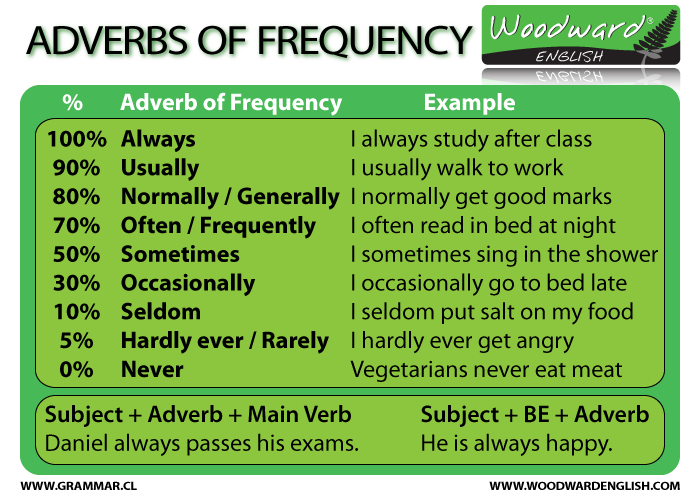UNIT 3
TEENS TODAY

Chores

CHORES, GOOD FOR YOU, GOOD FOR YOUR FAMILY
You can learn a lot from doing household chores. Chores help you learn about what you need to do to care for yourself now and in your adult life. When you contribute to family tasks, you feel competent and responsible. Even if you don't enjoy the chore, you get the feeling of satisfaction that comes with finishing the task. This helps families work better because parents have less to do so they have more time to do fun things with you.
WHAT'S YOUR CHORE?

What to clean:

What time do you wake up? What do you eat for breakfast? How do you go to school? What time do you go to bed? How long do you sleep every night? What do you do every day?
All the activities you do everyday make your DAILY ROUTINE.
Can you express it in English?
To talk about our daily routines we need to express ourselves using the PRESENT SIMPLE form of the verbs.
Do you know when and how to use it?
The Present Simple
Daily Routines
What is your daily routine?

Jobs
Not everyone's daily routine is the same. For example, did you know that some doctors, nurses, fishermen and bakers work at night and sleep during the day?
Do you know what's your ideal job? Find it out by completing this quiz.

Which of these jobs do you know?
Let's find it out...
Let's revise a little...

Think of a job and do not tell it to anyone.
Write some lines about it. Then, people will try to guess it.
Here you have some questions to help you:
-
Where does he work? He works in an office / in a factory / in a hospital
-
Who does he work for? He works for a car company / an airline / on his own.
-
What does he do? He designs buildings / He meets clients / He goes to meetings / He writes reports / He makes phone calls / He types reports...
-
How many hours does he work? He's got a full time job (40 hours a week) / He's got a part-time job (15 hours a week) / He works long hours / He works from nine to five.
-
When does he work? He works at night / He works only in the mornings / He works in shifts.
-
What type of clothes does he wear? He wears a uniform / He wears a suit / He wears a white coat / He wears overalls.
-
Who does he work with? He works alone / He works with ten more people...
-
How much does he earn? He earns a lot of money. He doesn't earn very much.

VIRTUAL HIGH
Watch this video carefully. Try to remember every detail. After watching it twice, you will be tested...
Action Verbs

Let's play and revise!
Let's practice
LISTENING: Workbook page 27 n. 3, 4
Workbook page 25 n. 1, 2
page 26 from 1 to 5
FANCY A KAHOOT? (Present Simple 1)
Adverbs of Frequency
Along with the present simple tense we may also indicate how often we do these routines. Then we need the help of the adverbs of frequency. Here you have some:
Workbook page 25 n. 3, 4
REVISION
ANY PROBLEMS WITH YOUR HOMEWORK?
Workbook page 28 from 1 to 4
page 24 n. 1, 2, 3
First, let's practice a bit of listening: Listen to two students and answer some questions here.

Do the activity "Celebrity Children" in your Google Classroom

PROJECT TIME!
Please, show us how interesting your life is!
Tell us about a day in your life, any day, just choose which.
WHAT'S YOUR LIFE LIKE?

How can you do it? Easy! You have many options to choose from, choose the best option for you.
You can create:
-
a 3 - 4 minute video.
-
a Power point, Prezi to help you with your oral presentation for your classmates.
-
any other option on which you agree with the teacher.
Task 1
Before you start working on it, you need to plan what you are going to communicate. Make sure:
1. You remember what 3 parts any written or oral text include. How can you adapt it to your task in this project?
2. What linking words and details you can include in your presentation or video to make it more interesting and attractive to your audience.
This will make a significant difference in the quality of your speech. Have a look at the videos your teacher shows you to help you organize your text. Use them to get good ideas for your project. Write down all your ideas on your notebook
Task 2
Once task 1 is completed, it's time to create the text you are going to communicate.
Write it down adding all the ideas you got from task 1.


Task 3
It's time to create your multimedia support for your presentation: Power point, Prezi, Video.... this is where you can show us all your techie abilities ;)
Task 4
Once your multimedia support is finished, it's time to rehearse so that your fluency is correct and there are no problems with your pronunciation. This is a very important task so that you can do well on the day of your presentation.
There are also some useful tips you can follow. Watch these videos and find them out

Task 5
You will be evaluated by your teacher, your classmates and yourself!

TO DO SOME MORE LISTENING PRACTICE, CLICK HERE


























